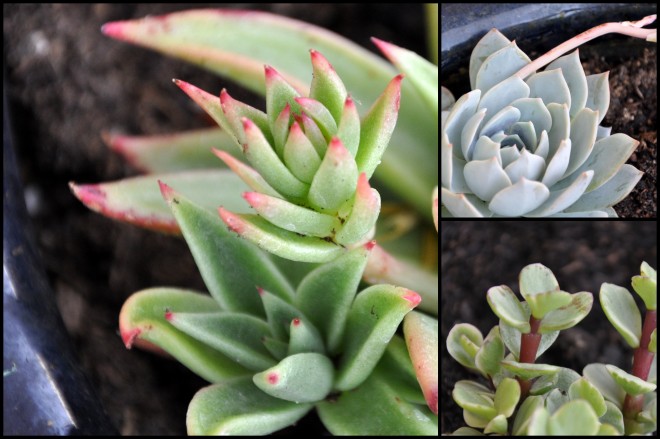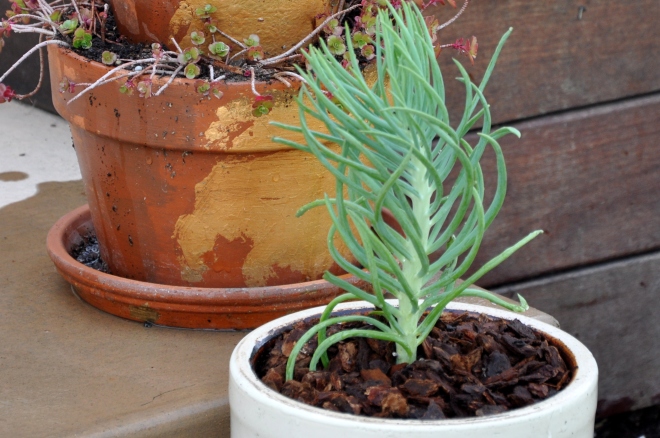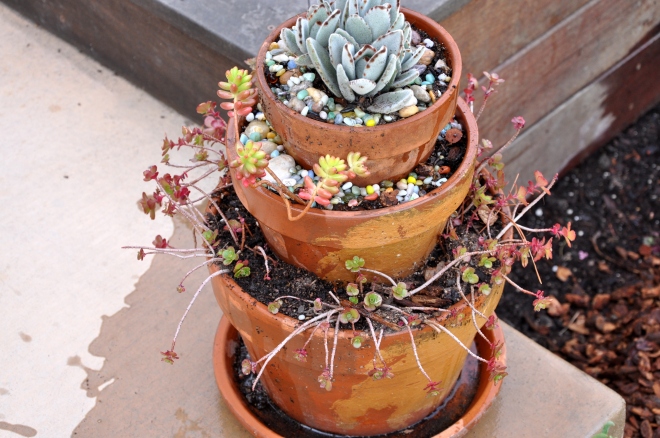Thomas Kuhn used the duck-rabbit optical illusion to demonstrate the way in which a paradigm shift could cause one to see the same information in an entirely different way. Source, Wikipedia
I’m applying those principles to my garden. Instead of simply planting what I like year after year, I’m now thinking about water conservation first, then figuring out from there what to plant. This isn’t a new reality for our semi-arid climate. In an average year, our rainfall is a mere 14 to 18 inches (35 to 38 cm).
Living in a developed country, we take water for granted. We open a faucet and water flows: fresh, safe and abundant. Actually, the first two are correct, but as we face year two of a drought, further complicated by an unseasonably warm winter and spring, abundant may no longer be the case.
We’re making incremental steps to reduce our water usage. While these changes are small and, forgive the cliché, a mere drop in the bucket, I think they’re worth doing.
Last week we finished removing the lawn from the sidewalk strip. This allowed us to cap off several sprinkler heads, and divert a smaller amount of water to one raised flower bed.
Over the weekend, I reduced the number of water-thirsty pots by half, then planted what remained with succulents. Native to warm, dry climates, succulents can go days without a drink.
Instead of lavender, drought-tolerant Mexican Bush Sage lines the deck.
There are a number of things you can do to improve water efficiency, but we’re already doing them:
- Watering in the early morning
- Use of a drip-irrigation system, delivering measured water directly to the source to avoid run off and rapid evaporation.
- Use of native plants
- Mulch to preserve moisture in the soil
The next logical step is to replace the lawn. Once a status symbol of the rich, water-thirsty lawns eventually found their way into suburban gardens. I hope their popularity is on the way out.
Major changes are time-consuming and costly, so we are making our changes incrementally.
Here’s what we planted:

- Left, Echeveria agavoides * Upper right, Echeveria peacockii * Lower right, Rainbow Elephant Bush Portulacaria afra ‘Variegata’
The other part of the water equation is indoor use. I’ve ordered a free water audit through the City of San Jose. They read your water meter, check for leaks, and determine water flow from sinks, showers and toilets. They make suggestions for laundry and dishwasher efficiency, shower duration, etc. They’ll audit our garden use as well. I’ll report back when they complete our audit next week.
Have you ever made a paradigm shift? Please let me know in the comments below.




Have I ever made a paradigm shift? How much time have you got? 🙂
My daughter loves succulents and has planted them extensively in her garden. I have always been a lover of the cottage garden effect which originated in rain abundant England and which can still be done here if you live in the right part of the country…… I never really appreciated succulents until I observed and listened to my ED’s love and pride in her garden. On my last visit I was utterly blown away by her gorgeous array of succulents interspersed with Mediterranean plants and some native plantings – it is so effective and maintenance light too!
LikeLike
LOL, Pauline. What’s your most recent? Or most profound?
I shared your bias for cottage gardens over succulents. I’m still a huge fan. But until I move to Seattle or London, I’m going to have to limit myself. I met a local gardener last year via free-cycle and she had a lovely succulent garden. She lost a lot of it in the early frost. Since these pots are small, I’ll try wrapping them in frost cloth when the time comes to help them winter over.
Do you have any photos of your daughter’s garden?
Oh and yes, low-maintenance for sure.
LikeLike
Xeriscaping was something I learned during my 6 years working for a landscape architect in California. I planted the lavender in my sons yard next to the fence where his neighbor chronically over-watered into my son’s yard. Hey, if he was willing to waste the water, I was willing to make use of it. The lavender made a nice barrier of good smell from their ignored golden retriever. I also put in a succulent garden. I love succulents. Not sure how it’s all doing these days and I’m afraid to ask. He does have drip systems in place. My succulents didn’t do well when I had to move them indoors this winter. Look forward to seeing the results of your experiment. Wish I could send you some of our rain but we won’t get any this summer either.
LikeLike
Hi Marlene,
I didn’t know you worked for a landscape architect. I would love to hear more! That must have been an interesting job, and one full of learning experiences too.
I toured a Xeriscaped garden a few years ago here in San Jose. It was spectacular. I feel like I gardened and had landscaping done first, then learned after the fact. It’s hard not to have your own garden biases. I’ve always loved the idea of a cottage garden but much more suited for you in Seattle. I wouldn’t mind a bit of your rain. We’re actually supposed to get some rain tomorrow. Fingers crossed.
I wonder why your succulents didn’t fair well indoors? Do you think it was the more limited light? Will you take them back outside to see if they’ll recover?
LikeLike
It is surprising how tough some plants are. We went through 10 years of drought, with water restrictions that forbid hose watering of the garden. The main plants made it through, with just buckets if waste water from the kitchen and bathroom. Some gardeners rigged up grey water systems and many of us now have water tanks. And amongst it all was that paradigm shift away from the tender annuals to tough plants and succulents. Many of the plants are native to California, so you should have a lot to choose from.
I know you are up to the challenge!
LikeLike
Thanks, Anne. I’m interested in learning more about the grey water systems. I clipped an article from our local paper, but I’ve not yet followed up. It makes great sense, doesn’t it? The woman in the article takes a 5-gallon bucket into the shower with her and collects the run off. I tried that once many years ago, but I sloshed water all over the place, and made such a dangerous, slippery mess, that I didn’t do it again. Our bathroom has a sky light but no window. That would have been the easier thing to do. Lots of ideas out there. Time to find more of them that work.
Thanks for your moral support!
LikeLike
There is a lot of info about grey water systems. As I said, I don’t use one, but from my reading there are a few things to be careful of. One, of course, is to not use toilet water or other sources that may be contaminated by human waste. Another is to be careful of the washing powder you use. I think the issue is high salt content and that can be dangerous for the garden. I know of some people who move the outlet pipe around their garden to stop the build up.
Another thing to be aware of is that water is HEAVY!! Lugging buckets gave me a new respect for women and children in developing countries who have to carry water for miles everyday.
So go forth and be a Green Warrior Woman!
LikeLike
I’ll keep you posted, Anne. I was going to start my research today, but my list of things to do is long, so that gets pushed to the back burner. It would be nice to have something in place before the dog days of summer.
Thanks for championing the cause.
LikeLike
I live in one of those semi-fussy California neighborhoods – without rules…but with neighbors who have always had a fit when homeowners dug up their lawns for drought-tolerant gardens. Now the city is PAYING you to do it. 🙂 How’s that for a shift?!
LikeLike
That is a remarkable shift and I love it! It’s about time, isn’t it?
I’ve been reading about various rebates locally for people who ‘go native’ with landscaping. I’m seeing signs, too, at the nurseries. That’s where I learned about the water audit. I can’t wait to see what we learn.
LikeLike
You’re working really hard to make a difference in your water usage, Bravo Alys. I didn’t even know you could get a ‘Water Audit’ done. That’s going to be really interesting. Once you know if there’s waste and where it comes from you’ll have the smallest water bill ever.
I’m afraid I don’t know much about succulents. They just aren’t much used in northern gardens. Although I did have ‘Hens & Chicks’ and ‘Sedum’ in my previous garden and they came back every year. I don’t think they’re true succulents though. I should look that up. I see a fair number of grasses and rock used now in landscapes here. There are still a lot of neighbourhoods filled with lush lawns. But in central Edmonton, the yards are so small, it’s not as common. We won’t have much yard at all. The rear yard is mostly patio.
I first saw a bunny with weird ears in the illustration. Once I read the caption, I could easily see both. The duck reminded me of a Doe-Doe bird though 😀 Water is going to be a rare commodity for many many people on earth. Very kind of you to be thinking about your legacy now. The guilding on your stacked planter pots is hanging in really well too. Love those! xoxok
LikeLike
Thank you, Sweet Boomdee. I know there is so much more we can do. So much of this is becoming aware. I love the look of a cottage garden as Pauline described but need to find the balance. That said, it is amazing how many beautiful native plants there are.
Will you plan a patio garden in your new place or will you wait to see how it goes? I’m impressed that you can grow Hens and Chicks in Alberta and have them come back every year.
I think I saw the duck first, but now I’m not sure. It’s interesting how these things can trick your eyes.
Thank you for your support and affection. xoxxooxooxox
LikeLiked by 1 person
Since moving to our hillside home with just a south-west facing slope to garden in, with very well-drained soil, I have focussed on getting plants to flower with NO watering at all! Last summer was a challenge – a very hot June and July with no rain at all, but it works! It takes time and patience, with lots of things dying on me (most don’t get a second chance). Hard winters make it more challenging, but I’m getting there! Grasses are good, sage and sedums/sempervivums too. I think it’s great what you’re doing, and wish you lots of luck with the new plants. 😀
LikeLike
Cathy, I’m really impressed. Way to garden within your native requirements. No water? I’m stunned.
I like grasses (we have several) and I’ve tried sedum too. I need to keep taking it further and further, till we are completely water (and native) efficient.
xox
LikeLike
Beautiful selection of plants Alys! We sign up every year for a sprinkler program which saves us money on our water bill, and since we have our garden, we have a bunch of rain barrels to collect natural rain water so we can water our garden. The rain barrels definitely help cut down on the water usage in the summer. One good rain can fill up a 50 gallon rain barrel quickly! They have definitely saved us on a huge water bill by using them. ❤
LikeLike
Thank you, Val. I really like the variety. It will be fun when they flower, too.
What is the sprinkler program? I would love to hear more about that.
I’m delighted to hear you have rain barrels and that they work so well. They’re a great idea for folks with decent seasonal rain and snow. Does the water in your barrel freeze or is it insulated? Tell me more, please!
LikeLike
The sprinkler system with our water company is just something that we found out about last year where we just signed up for it and it gave us a flat rate off the bill. As for the rain barrels, we only use them in the summer to water all of our flower beds and the garden. They are not insulated, as we have to drain them for the winter. They have a water spout near the bottom of the barrel, a hole in the top where you hook up a gutter extension that runs the rain water into the barrel, and they are raised up on bricks. Then, all we do is either hook up a garden hose or place a watering can under the spout to get the water out. One good rain can fill up a 50 gallon barrel. I think I only had to use the house hose to water the garden twice last year, so all of our watering was done with the natural rain water. It truly saved us a lot of money by using a rain barrel. Check out some of our gardening posts from last year to see the blue rain barrel & the gutter extension we used. (if you can’t find the post, let me know)
LikeLike
I’m impressed. You’ve got a fabulous system going there, efficient and simple to use. Congratulations.
I will try to go back and read some of your gardening posts. That sounds like fun.
LikeLike
Such great suggestions, Alys.
We do have much more rain than you do, and several friends are using rain barrels as a way to capture / reuse rain. (Oh! I just saw that Nikitaland just mentioned these as well).
I love that you are a conservationist … one more reason to love you!!!
LikeLike
Awww…you are so good to me. We have to giggle at the idea of a rain barrel around here. We’ve had six inches of rain the entire year. When my in-laws lived in Calistoga, they averaged 70 inches a year. Sigh.
They are a great idea though, for folks who get rain and snowfall. I think they’re brilliant.
LikeLike
We had a water audit done several years ago when we bought our house on the Stanford campus and inherited a very old, leaking irrigation system. In our south facing front yard, we noticed that the existing manzanitas, Ceanothus and toyons (almost all volunteers planted by the birds) actually looked better once the water was turned off – that made us realize we’d be better off going native and eliminating the irrigation system in the front yard all together! We added more manzanitas, ceanothus & toyons as well as Salvia Pozo Blue sage, poppies and native myricas. After one season of hand watering to get them established, they’ve all thrived with NO supplemental water whatsoever! As an added bonus, all of the natives in our front yard are maintenance free; they actually prefer to be left alone, so no pruning, fertilizing or fussing is required. In our back yard, we replaced our lawn with a vegetable garden and replaced the old irrigation system with drip (very easy to install yourself!). In our courtyard, we planted loads of succulents (mostly in pots so we could move them around as needed). With just those changes, our water consumptions was cut in half! Some of our neighbors were initially critical of our native front yard, but now that the plants are all established, it’s absolutely beautiful. Personally, I’ve always preferred a more natural look anyhow so it suits us just fine; the biggest bonus for us was the increase in the number of birds (mostly hummers and quail) that began to frequent our front yard. We found the Las Pilitas Nursery website really helpful.
LikeLike
Funny you should mention the water audit. We had one last week, though I’ve yet to blog about it.
Your garden sounds glorious, and how astute of you to notice and take action accordingly. An arborist told me that trees get too much water when they’re planted with lawn near the roots. Now that we’ve capped the sprinklers in the sidewalk strip, I hope the tree does even better.
Going native makes a lot of sense. We have a silly love affair with our suburban lawns, so I can understand your reluctant neighbors. I’m glad you forged ahead anyway. I’m moving in that direction, but still need to convince my husband.
I’ll check out the Las Pilitas Nursery. Thank you.
LikeLike
If it’s any help, my husband was convinced the moment I mentioned we could get rid of the lawn mower 🙂
LikeLike
LOL!
LikeLike
I love your succulents. I am always so bored of the lame selection that we are given over here. and if there is something unique well then they want and arm and leg for it. Really nice colours and textures. Love the stacked pot too. GOSH SAKES Alys. You have been SOOO BUSY!! i can’t even keep up with your posts!! 🙂
LikeLike